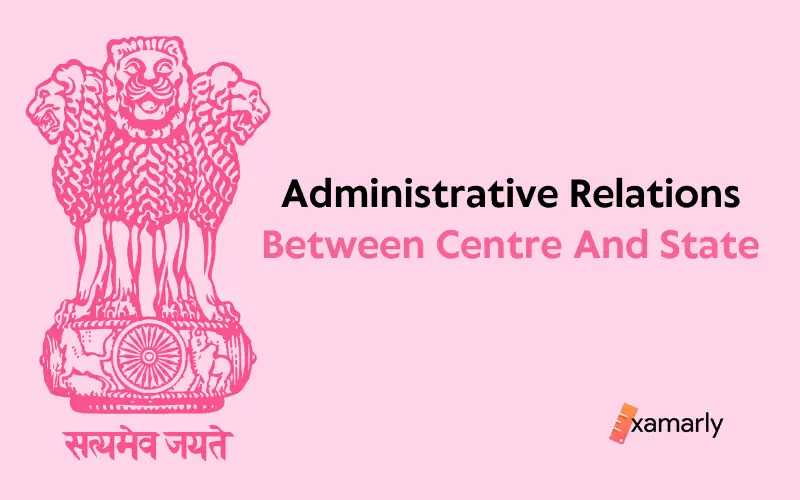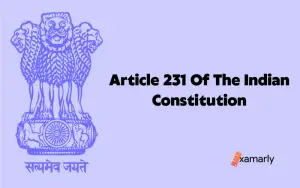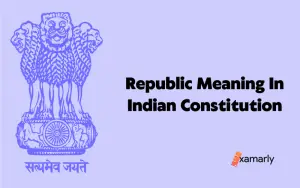This article on administrative relations between the centre and state will discuss the administrative ties between both the central government and state government.
Various government policies laid down in the Indian Constitution are crucial for the democratic functioning of the country and the idea of national federalism at large.
The Constitution defines the distribution of powers between the state and the centre. The Constitution talks about the division of powers such as legislative power, executive powers, and financial powers and the role the centre-state relations play in each.
In Articles 256 to 263, included in Part XI of the Indian Constitution, the federal and state governments of India are compared and contrasted from an administrative perspective.
This topic holds importance for UPSC Preparation for Indian Polity and Governance Syllabus.
The Centre-State relations in the federal structure of India are studied under three heads:
- Legislative relation
- Administrative relation
- Financial relation
Administrative Relations Between Centre and State – In Detail
Articles 256–263 of the Indian Constitution outline the central government-state administrative interaction.
In Article 246, the Constitution discusses various subjective laws that can be made by the Central Government and State Legislative Assemblies.
Three lists are mentioned in the Seventh Schedule of the Constitution dividing subjects between the Centre and States:
| List I | Union List |
| List II | State List |
| List III | Concurrent List |
In general, matters under Parliament’s legislative purview are within the Central Government’s administrative purview.
The State Government is in charge of the administrative matters contained in the State List. These lists define the federal structure of Indian democracy.
Distribution of Executive Powers
- The whole nation is under the executive authority of the Centre. Even in locations where the state legislature has exclusive authority to enact laws, the executive branch of that state retains authority.
- Unless the Constitution or an act of Parliament expressly vests it in the centre, the executive power remains with the states when both the state legislature and the Parliament have legislative jurisdiction over a certain matter.
Directions to the States
In line with the Administrative Relations between Centre and State governments, States are liable to follow directions of the Centre for executing their executive powers in the areas given below:
- governmental efforts towards building and maintaining a reliable network of communication facilities
- establishing and enforcing special programmes for the benefit of the state’s Scheduled Tribes.
- Preparing for and carrying out the state’s welfare program(s) for the Scheduled Tribes is one of the state’s responsibilities.
- Article 365‘s coercive punishment underpins the Central Directions in some cases.
Related Concerns
- There is an unbalanced state when it comes to legislative authority between the centre and state governments.
- This results in a situation where the states can not ask the Parliament of India for passing legislation on a state’s issue. Likewise, the Centre lacks the authority to delegate legislative authority to the states.
- In the executive division, a sharp division can lead to clashes between the central government and the state government. As a result, inter-state assignment of executive responsibilities is permitted by the Constitution in order to reduce rigidity.
Cooperation
- Parliament can adjudicate any dispute between two states pertaining to the consumption, distribution, and management of waters of inter-state rivers and/or river valleys.
- Under Article 263 of the Indian Constitution, the President of India can fabricate an Inter-state Council to look into topics of mutual interest between the Centre and States. In 1990, the Inter-State Council was set up.
- All governmental acts, legal papers, and judicial proceedings issued by the Union or any State will be given full faith and credit throughout India.
- Parliament may appoint competent agencies to execute interstate trade, commerce, and communications constitutional provisions.
Obligations
- In order to give the Centre enough authority to use its executive dominion completely, the Constitution establishes two constraints on the state’s executive control and the subsequent centralisation of power
- This resulted in a limitation on the state’s executive power that it could only be exerted in the ways described below:
- It must ensure compliance with parliamentary legislation and/or any existing law pertaining to the state.
- The state does not obstruct or prejudice any sort of exercise of the Centre’s executive power in the state.
- In contrast to the latter, which imposes a broad duty on the state, the former imposes a particular responsibility on it: it must not interfere with the Central government’s executive authority.
- Article 365 allows the President to declare that a state’s administration cannot be carried out in conformity with the Constitution if it fails to follow Centre orders.
- Thus, Article 356 may be used to bring the state under presidential authority.
- Both The Centre and the States have their own public services. They are referred to as Central Services and State Services.
- Centres and States share the control of all Indian services like IFS, IPS, and IAS. The Centre has the ultimate control but the state has direct control.
- However, only the Parliament has the power to form additional “all-India service”.
- A public service commission and its body can only be designated by the President. The authority of removal is also with the President of India.
- The UPSC is in charge of developing recruitment strategies and selecting candidates for certain programs.
- The president, governor, and Chief Justice of India choose high court justices.
- In some circumstances, the Central Directions are supported by the coercive penalty outlined in Article 365.
- In a financial situation, the Centre may order states to adopt economic propriety canons and reduce state employee salaries. (Article 360).
Consider Examarly, an ed-tech platform to fast-forward your UPSC Preparation.
Conclusion
The Indian Constitutional Machinery aims at establishing cooperative federalism in India. The States are given specific autonomy in various regards.
The Administrative relations and division of powers between the Centre and State governments clearly show this.
This ensures that administration and policies on all levels stay efficient and nobody, knowingly or unknowingly, creates contentious issues in the other’s administrative work.
However, to maintain a balance the Centre is obviously given more power over the State. This, sometimes, create political power tensions and national issues in centre-state relations.
We hope this article helped you with your query about the basic structure of Administrative Relations between the Centre and the State.






